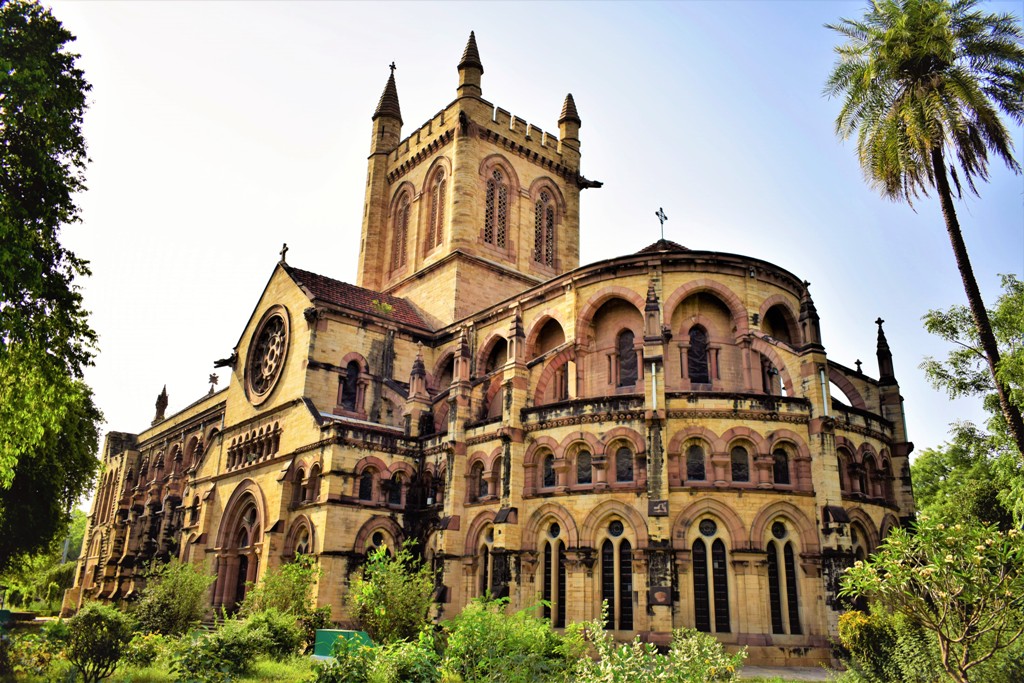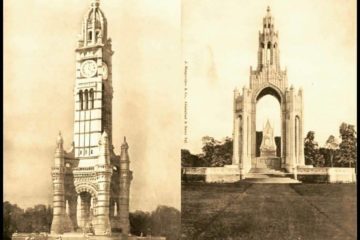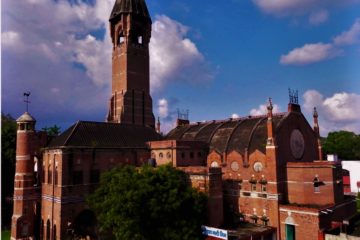All Saints’ Cathedral, Allahabad
Published by admin on
All Saints’ Cathedral
Written by: Nilesh Narayan
Founder: Holy Waters India Journeys
Allahabad (now Prayagraj) the erstwhile British capital is home to some of the oldest churches of north India depicting the absolute history of its colonial past; so is also known as the ‘City of Churches’. There are around a dozen colonial era churches in the city that pay tribute to various forms of architecture that flourished during the Victorian age such as; Colonial, Neo-Colonial, Gothic Revival, Roman-Italianate, Indo-Roman and Greco-Roman etc. The city is often regarded as the Canterbury (The English Cathedral City) of the east by the local Christian community.

A vintage photograph of All Saints Cathedral
“If you want a cathedral, we’ve got one to spare”
Though rare in this part of the world! The city of Allahabad is blessed with two cathedrals – One Catholic & One Anglican, in two contrasting styles. The Anglican Cathedral ‘All Saints’ Cathedral’ is a Gothic masterpiece unlike like its Catholic counterpart though older ‘St. Joseph’s Cathedral’ (Built in 1879) which is a classic Italian style Roman Catholic Church situated at west of Alfred Park. The Cathedral comes under the ‘Roman Catholic Diocese of Allahabad’ (one of the largest Dioceses in the world, since 1886) while the history of the church has some deep connections with the missionary expeditions to Tibet and Nepal.
The All Saints’ Cathedral
All Saints’ Cathedral, also known as Patthar ka Girja (Church of Stones) is an Anglican cathedral located in the civil lines (formerly Cannington) area of the Allahabad city. Built in the memory of Bishop Clifford, The church is considered to be the finest Anglican Cathedral in Asia. Inspired by the Gothic style of churches that were constructed during the 13th century, the cathedral was designed by the well-known British architect, Sir William Emerson one who designed the Victoria Memorial in Kolkata. The church is one among the few Gothic Revival buildings that were built by the British during their rule in India.

The Church
PC: Vaibhav Maini
The design for this cathedral was started off in 1887 and construction was over by 1891. November 1st, the anniversary of this church is celebrated as ‘All Saints Day’ and belongs to the Church of North India Society. The church is constructed in a large open space at the intersection points of two of the biggest roads of Allahabad, M.G. Marg (Canning Road) and S.N. Marg formerly Queen’s Road.
Cannington and Canning Road is named after Lord Canning, Governor-General of India from 1856 to 1862
History
The idea behind the design of the church was based on the thirteenth-century choir of Canterbury Cathedral in Kent (the cathedral of the Archbishop of Canterbury since 597 and leader of the Church of England) which was conceptualized during 1871 itself. The Lieutenant Governor of North Western Provinces, Sir William Muir donated the land for construction of the church. It was on April 10th 1871 that the foundation stone for the structure was laid by Elizabeth Huntly Wemyss, wife of Sir William Muir. Famous architect from Britain, Sir William Emerson was chosen to design the structure of this cathedral. He had already designed the Crawford Market of Bombay and the Muir Central College in Allahabad (University of Allahabad) and later Victoria Memorial in Kolkata.

According to ‘The Building News’ (An architecture journal, published in U.S.A. during the late 19th and early 20th centuries) This church was commenced some 15 years ago and was at first intended for the cathedral of the North-West Provinces and was designed to accommodate some 300 or 400 persons with open verandah and ambulatory all round. However it was decided later that the cathedral of the North-West Provinces should be at Lahore instead, though it is now thought probable that this will eventually form the cathedral church of a new dioceses.


Allahabad was first thought to be a very small city; with the developed railway network, Allahabad grew by leaps and bounds and now is big enough to accommodate a big choral group. In some circles of city it is believed that the cathedral was actually planned to be raised in Australia but due to a postal lapse it got assigned to Allahabad, simply by chance.
However it is an incomplete church, as the building never received its intended twin towers on the main entrance, although a tower over the crossing was completed. It was consecrated in 1887 but it took another 40 years for it to be completed.

The original plan of the All Saints Cathedral with twin towers

In order to combat the heat while keeping in mind the weather conditions of the city the huge structure had couple of carriage porches and low windows that can be filled with wet cuscus mats during the scorching summers. In order to support destruction from white ants the roof is supported by arches at the same time as the workmanship of the church pompously reflects the best skills and expertise of the available talents during the ‘British Raj’.

Architecture
Surrounded by lush green garden the cathedral is brilliantly embellished with cream Chunar sandstones together with fine red sandstone dressings where the roof is covered with red native tiles. The cathedral’s nave is about 40 feet wide and 130 feet long, Total length of the church is about 240 feet and the internal width is about 56 feet.


The intricate artistry of the marble altar and the stained glass panels at the cathedral ostentatiously replicates the magnificence of the colonial aesthetics even after 125 years of its glorious past. While the famous alabasterpulpit (the Bishop’s throne) within the edificeisengraved in the style of the Lahore School of Art and regarded as a remarkable piece of workmanship by Mr. Nicholls of Lambeth. In addition to this the Church houses many plaques and tablets depicting the death of several British nationals during their rule in India.


The lantern tower of the cathedral is regarded as Victoria Tower also it is astonishing to see the historic building stationed beautifully at the center of a large open space with the crossing of four of the principal roads, each being about 100ft. wide.

The Architect

Sir William Emerson (3 December 1843 – 26 December 1924) was a British architect, who remained President of the Royal Institute of British Architects (RIBA), 1899 to 1902, and had worked extensively in India. He was the original architect chosen to build Liverpool Cathedral.
Famous Works by Emerson:
1869 – Crawford Market, Bombay, India
1870 – All Saints Cathedral, Allahabad, India
1872 – Muir College, Allahabad
1878 – St Mary the Virgin Church, Brighton, Sussex
1879 – Takhatsinhji Hospital, Bhavnagar
1894 – Nilambag Palace, Bhavnagar
1896 – Clarence Memorial Wing St. Mary’s Hospital, Paddington, London
1905 – The Victoria Memorial, Calcutta, India
It is interesting to know that many of the churches in Allahabad are built in the East to West direction with few quite an exceptions.

A cruciform plan of cathedral



0 Comments